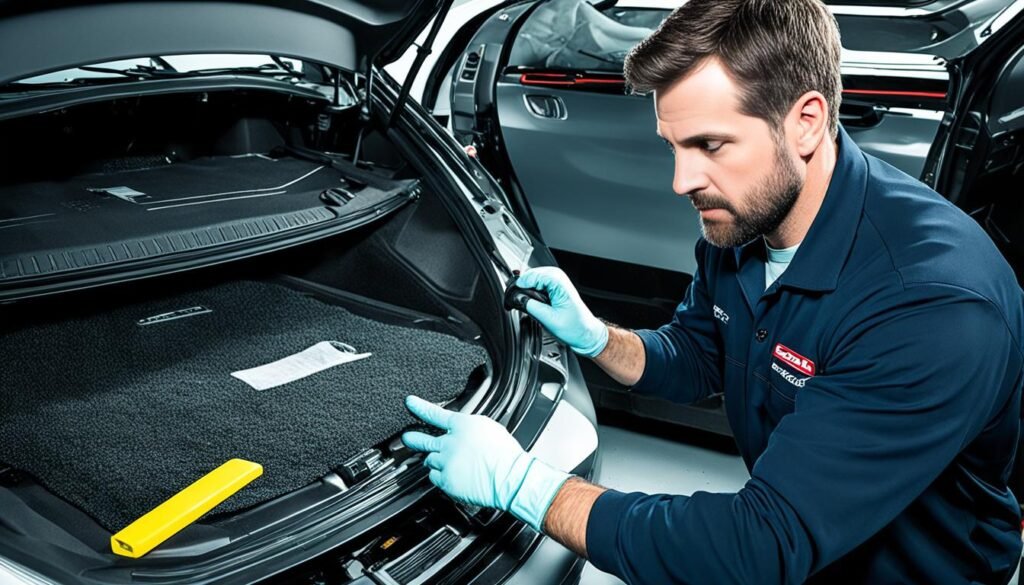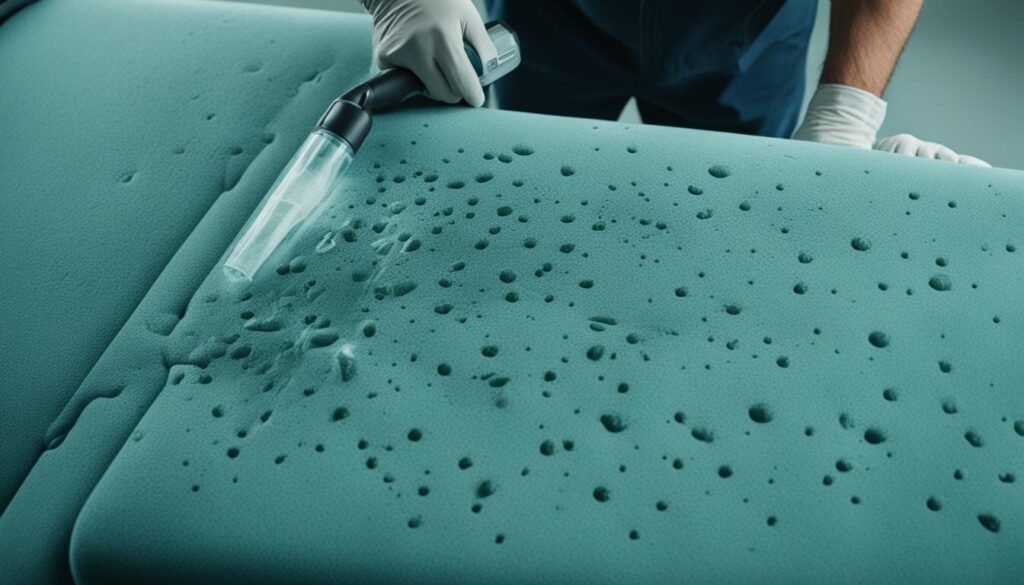Did you know that up to 1 million vehicles damaged by floods are resold each year in the United States? Buying a car with hidden water damage can cause big problems with the electrical system, engine, and interior. It’s important to know how to spot water damage when looking at used cars. This guide will give you tips to find water damage in cars and help you make a smart choice.
Key Takeaways
- Water damage can severely compromise a vehicle’s functionality and longevity.
- Identifying the signs of flood-damaged or water-logged cars is crucial when buying a used vehicle.
- Unusual rust, musty odors, and moisture intrusion are all red flags that may indicate a history of water exposure.
- Performing a thorough inspection and checking the vehicle’s history can help you avoid purchasing a water-damaged car.
- Consulting with a trusted mechanic or specialist can provide additional expertise in evaluating a used car for signs of water damage.
Identifying the Signs of Flood-Damaged Vehicles
When checking out a used car, it’s crucial to see if it has flood damage. Cars damaged by floods can be dangerous and unreliable. Look for musty smells and rust in odd places to spot these issues.
Musty or Mildew Odors
A musty or mildew smell is often a sign of water damage in cars. This smell comes from mold and mildew that grow in wet conditions. Check the carpets, seats, and other fabric for mold or mildew signs. This could mean the car had water problems.
Rust in Unusual Places
Seeing rust in places not usually rusty is another flood damage clue. Check the pedals, inside the hood or trunk, and other metal parts for early rust. This rust means the car was in floodwater for a while.
| Indicator | Description | Potential Flood Damage |
|---|---|---|
| Musty or Mildew Odor | Persistent, unpleasant smell | Mold and mildew growth due to water exposure |
| Unusual Rust Locations | Premature rust on components not typically exposed to the elements | Prolonged water exposure and corrosion |
By looking closely for these signs, you can figure out if a used car might have flood damage. This helps you make a smart choice about the car’s condition and safety.
How to Tell if a Car Has Water Damage
When looking at a used car for flood damage, there are key steps to follow. A detailed pre-purchase vehicle inspection is vital to avoid buying a water-damaged car.
Begin by checking the car’s interior. Look at the carpets, upholstery, and other fabric parts for moisture, mold, or mildew. These signs could mean the car faced water. Also, check the headlights and taillights for condensation, which might show water damage.
Don’t forget to inspect the car’s electrical parts. Make sure all lights, switches, and electronics work right. Rust under the dashboard or in the trunk could also point to water damage.
- Thoroughly inspect the interior for signs of moisture, mold, or mildew.
- Check the headlights and taillights for condensation buildup, which could indicate a compromised seal.
- Examine the vehicle’s electrical components to ensure they are functioning properly.
- Look for rust in unusual areas, as this can be a sign of water damage.
If you find any of these signs, getting a professional mechanic to check the car is a good idea before buying. It’s important to spot water damage to protect yourself and avoid buying a flood-damaged car.
| Inspection Area | Potential Signs of Water Damage |
|---|---|
| Interior | Moisture, mold, mildew |
| Lights | Condensation buildup |
| Electrical Components | Malfunctioning features |
| Undercarriage | Unusual rust |
Being careful and doing a thorough inspection helps you avoid the risks of buying a car with flood damage. This way, you can make a smart choice when buying a car.

Identifying water-damaged vehicles is crucial to protect yourself as a used car buyer and ensure you don’t end up with a flood-damaged car.
Conclusion
Checking for water damage in a used car is key to avoid expensive repairs and safety risks. Knowing the signs of flood damage, like musty smells, odd rust, and faulty electrical parts, helps you make a smart choice. Always get a detailed check from a pro and walk away if you spot water damage.
Staying alert and taking steps to protect yourself ensures a safe and dependable drive. By being careful, you can dodge the problems of buying a car with water damage. This way, you get the peace of mind that comes with a car in good shape.
This article offers advice on spotting water damage and making a wise choice when buying a used car. Keep your guard up, listen to your gut, and put your safety and happiness first. This will help you find the perfect car for you.


